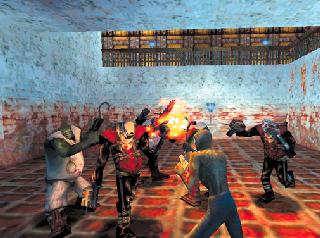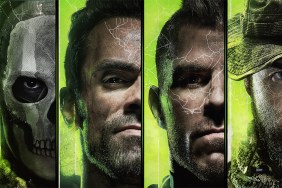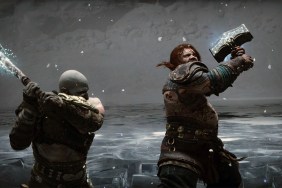That Voodoo That You Do
More than a fashion accessory, the Mask of Shadows is grafted into Michael LeRoi’s
chest. With the voodoo powers of the mask, LeRoi can become Shadowman,
a being of immense power and the ability to cross over into Deadside, the realm
of the dead. Mama Nettie, a voodoo priestess, has used her powers to receive a
dark omen of an immense evil gaining power within Deadside. In order to stop the
forthcoming Armageddon, she instructs LeRoi to journey into Deadside, find the
Asylum (a haven for dead killers and Dark Souls) and destroy it. Why worry? It’s
not like you can die or anything…
Shadowman
is the newest 3D platform title to come down the pipe. With a creepy mood and
adult subject matter, this game doesn’t treat you like an eight year-old. Shadowman
has made its rounds through all the systems, and now it has arrived on the Dreamcast.
The voodoo is the same to the end, as this version is almost the same as the PC’s.
You control Shadowman from a third person view, focusing on exploration and collection. All the while, you must shoot the lost souls and demons that try to hinder your quest (how do you kill something that’s already dead?). The main items that you must collect are the Dark Souls; the more you collect, the more locked gateways on earlier levels you’ll be able to open and the stronger you’ll become. Other voodoo items will let you touch fire or climb up waterways.
Shadowman uses a combat aiming function similar to Legend
of Zelda: Ocarina of Time. You can lock-on to an enemy, and then move relative
to him. While the function works decently, Zelda‘s “lock-on” had a cleaner,
more refined feeling. In Shadowman, the lock occasionally gets lost when
you step too far to the side or if something comes between you and the enemy.
Furthermore, the lock is not very flexible and often you find yourself locked
on a distant enemy while a closer enemy claws at you. Needless to say, it sometimes
gets frustrating. I also just wish he could turn faster.
When you defeat an enemy, their soul is left behind. These souls nourish your
health. When you’re Michael and you die in the game, you just go to Deadside,
where you’re Shadowman. If you’re Shadowman and you die, you just
start again from a checkpoint since you’re already dead. Isn’t immortality great?
Overall, there is a lot of platform jumping in the game, but rather than being overly frustrating like other third-person games (*cough Tomb Raider 3 *cough*cough*), it feels easy and natural.
When you move between different game locations, you’ll get a loading screen.
Unfortunately, the loading screens really disrupt the flow of the game. The illusion
of a fully realized world would have seemed more convincing without the wait.
Even with the nonlinear nature of the game, the world of Deadside still has a
separated “levels” feel to it.
One neat feature is that the difficulty level keeps increasing as you get
further into the game. Areas that were nearly empty the first time through are
brimming with the undead the next time around. The enemies seem somewhat weaker
on the Dreamcast version than the others.
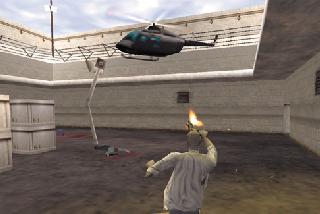 Influenced by movies like Seven
Influenced by movies like Seven
and the poetry of T.S. Eliot, the designers have created a very stylish game.
While the writing is infused with a feeling of deep meaning, the characters still
seem to follow standard archetypes, with the familiar good vs. evil . . . or in
this case, evil vs. evil-er.
On top of that, the characters could have used more exposition. If the back
story of LeRoi were included, gamers would feel more driven to keep fighting during
the times when they’re stuck looking for some key item. There is a comic book
called Shadowman that the diehard fans of the game can go pick up. I believe
that the comic book’s storyline is already dealing with a completely different
bearer of the Shadow Mask.
The graphics of Deadside successfully embody the dark and chilling mood set
by the plot. Because Deadside is an imaginary place, the different visual elements
of caves, gothic architecture, and dead things don’t have to follow the full rules
of reality. That said, there are certain areas of the “Liveside” that, in contrast,
just don’t look as good as Deadside (stupid constraints of reality). The Dreamcast
manages to look on par with the PC, but the framerate could have been tuned up.
Also, during key animation sequences, such as being transported from Liveside
to Deadside, everything is sped up. Its awkward and doesn’t set the mood like
the PC version did.
Sound-wise, Shadowman excels. The environmental noise, occasional music
with chanting, and shrieks of the enemies keep the game scary. The cries and screams
of the undead remind me of my former, crazy roommate who talked to himself; which
by itself is freaky enough for me (and the rest of us. ~ Ed.). In the Asylum,
you’ll find shrines devoted to various serial killers. As you enter one shrine,
the eerie chants of a Latin hymn start in the background; enter another shrine,
and you’ll hear rock-a-billy twisted into an evil noise. Shadowman is a
great game to play in the dark with the sound turned up, just make sure the neighbors
don’t get mad.
Shadowman‘s gothic, artsy flavor is certainly refreshing, and it is
almost equal to the PC, but underneath all the English Lit, the actual gameplay
isn’t all that innovative. While it isn’t new, the familiar elements of an exploration
game are done well. To the uninitiated, Shadowman can get tiresome quickly
due to loss of interest in the plot and repetitive exploration. For those willing
to keep searching the realm of Deadside, however, you’ll find an above-average
exploration in the world of the dead.
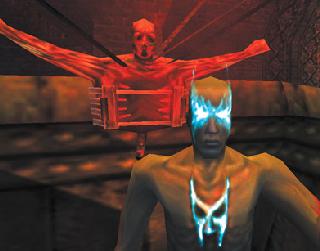
-
S-s-scary sound effects
-
Clean, tight controls
-
Literature infused storyline
-
Lots of non-linear exploration
-
Frame dropping
-
Some animation sequence problems
-
Easy to get lost
-
Nothing really new and different
